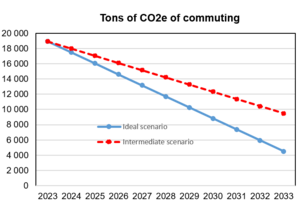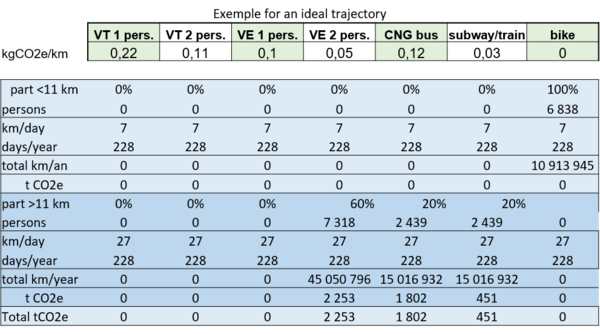Which trajectories to reduce commuting's greenhouse gases emissions?
CUMIN (C) March 2023
An ambitious but realistic plan on commuting could decrease
by 50% the commuting GHG of the University in 10 years thanks to various options to thermal vehicle.
Which is the priority among University's GHG?
In the 2020 carbon assessment of the Lille University[1], commuting represents 51% of GHG. Regarding this mobility, 81% of these GHG are linked to the 24% of thermal vehicle's trips (19 000 users). Reduce this "thermal" mobility by two would lead to a 20% reduction of the University's GHG.
Which changes to reduce commuting's GHG?
According to 2022 ADEME (National agengy on enviroment), transport emissions factors, several modes of transport allow a reduction of thermal vehicle (TV)'s GHG: from electric vehicle (EV) to bike. Each thermal vehicle user can choose a less polluting mode of transport.
Which could be the ideal trajectory for existing thermal vehicules'users?
The mobility survey of the University shows that the share of biking as a mode of commuting for distances exceeding 11 km is almost zero. Then, the 7 000 commuters travelling less than 11 km could use bikes. For the other 12 000 commuters, they could ideally use subway (20%), bus (20%) and e-car sharing (60%). This unrealistic distribution would lead to a 75% reduction of the GHG of their current mobility. Options are presented in appendixes.
Which ambitious but realistic trajectory for the next 10 years?
A realistic alternative senario has been studied: a reduction of 50% of the GHG emissions dues to the commuting of thermal vehicules'users. Then, this distribution could be the one presented in the table below (a part of the thermal vehicle is kept but it does not represent more than 10%).
An ambitious but realistic plan on commuting could decrease by 50% the commuting GHG of the University in 10 years thanks to various options to thermal vehicle.
Appendix – Calculating assumptions for 2 trajectories
Information from 2020 University carbon assesment
Commuting represents 51% of the University's GHG. Among them, 81% of GHG are dues to 19 000 thermal vehicles'users. Factors of emission which are considered here are those from the 2018 ADEME database (0.253 kg CO2e per km for an average thermal vehicle).
Information resulting from Lille University mobility survey
This mobility survey covered a sample of 4051 persons. From a 11 km minimum threshold distance, bikyng and scootering are negligible. The percentage of each transport mean is calculated in the 2 cases (before and after the 11 km threshold).
These percentages were appplied to the 81 000 users of the University. Regarding thermal vehicles'users (19 000), there are 7 000 users below 11 km and 12 000 users above. An average travel was calculated for the 228 working days to get the same GHG total amount for theses thermal vehicules'users (2018 ADEME emission factors):
- an average distance of 7 km between home and work (users below 11 km)
- an average distance of 27 km between home and work (users above 11 km)
Definition of ideal and intermediary trajectories
The 2 cases, according to the 11 km threshold, were studied for the 2 average travels, for 228 working days, but with the ADEME 2022 updated emissions factors (i.e. 0.22 kg de CO2e for an average thermal vehicle). Percentages are defined for each type of transport. The GHG total amount is then distributed on 10 years in order to get a progressive and gradual reduction.
The various hypotheses allow a global view with a quite hight uncertaintly. However, they allow: 1) to get this mobility's current GHG amount (from the carbon assessment), and 2) to give a commun frame to the different scenarios and then allow a qualitative comparison.
References
[1] Lille University 2020 carbon assessment, internal report, 2020.
[2] “Calculer les émissions « carbone » de vos transport », ADEME, 2020 [Online, seen on March 2023 https://agirpourlatransition.ademe.fr/particuliers/bureau/deplacements/calculer-emissions-carbone-trajets.













